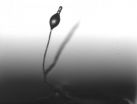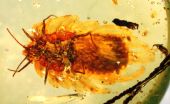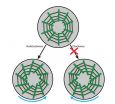Discovery of 2 new species of primitive fishes
2015-03-31
(Press-News.org) Saurichthys is a predatory fish characterized by a long thin body and a sharply pointed snout with numerous teeth. This distinctive ray-finned fish lived in marine and freshwater environments all over the world 252-201 million years ago during the Triassic period. Two new species of this extinct fish have been discovered by paleontologists at the University of Zurich, working in collaboration with researchers in Germany and China. The first species, «Saurichthys breviabdominalis», is named for its relatively short body and the second, «Saurichthys rieppeli», is named after Olivier Rieppel, a Swiss paleontologist formerly based at the University of Zurich. Including the new finds, there are now six species of Saurichthys known from Monte San Giorgio, making it both the most abundant and diverse fish at this classic Middle Triassic locality.
Evidence of different diet and habitat
Both 40 to 60 cm long fishes differ from other species of Saurichthys in skull and body shape. "These differences indicate different hunting styles and habitats in the shallow sea. This enabled multiple species to co-exist", clarified Heinz Furrer, paleontologist at the University of Zurich and author of this research project. According to Furrer, the ability to occupy multiple specialized feeding and habitat niches may be responsible for the evolutionary success of these fishes, both in the Monte San Giorgio basin and globally.
Monte San Giorgio is world-renowned for its beautifully preserved fossils from the Middle Triassic time (~239-243 million years ago). Large-scale excavations conducted by the University of Zürich between 1924 and 2004 yielded a substantial number of fossil reptiles and fishes. As part of a research project funded by the Swiss National Science Foundation, scientists at the Paleontological Institute and Museum, University of Zurich have prepared and studied over a hundred well-preserved specimens over the last three years.
INFORMATION:
Reference:
Maxwell, E.E., Romano, C., Wu, F. & Furrer, H. 2014: Two new species of Saurichthys (Actinopterygii: Saurichthyidae) from the Middle Triassic of Monte San Giorgio, Switzerland, with implications for character evolution in the genus. Zoological Journal of the Linnean Society 173/4. doi: 10.1111/zoj.12224
Contacts:
Dr. Heinz Furrer
Paläontologisches Institut und Museum
Universität Zürich
Tel: +41 79 328 26 66
E-Mail: heinz.furrer-paleo@bluewin.ch
Dr. Erin Maxwell
Staatliches Museum für Naturkunde
Stuttgart
Tel. +49 711 8936 145
E-Mail: erin.maxwell@smns-bw.de
[Attachments] See images for this press release:
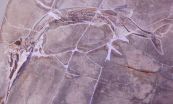
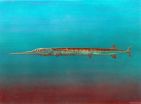
ELSE PRESS RELEASES FROM THIS DATE:
2015-03-31
Darwin's evolutionary theory predicts survival of the fittest. So why do different survival tactics co-exist, if evolution should always favour the winning strategy?
To answer that question scientists at the Universities of Bath and Manchester have been studying a single-celled amoeba, also known as slime mould, which displays certain behaviours that have been labelled as "cheating" or "cooperating".
In a study, published in the prestigious journal Current Biology, the team found that cheaters don't necessarily win in terms of overall survival, suggesting that biologists ...
2015-03-31
Scientists at the University of Bonn, together with colleagues from China, UK and Poland, have described the oldest evidence of brood care in insects: it is in a female scale insect with her young that is encased in amber as a fossil. The approximately100-million-year-old "snapshot" from the Earth's history shows the six millimetre long tiny insect with a wax cocoon, which protected the eggs from predators and drying out plus associated young nymphs. The researchers are now presenting their results in the respected journal eLIFE.
The small female insect with the waxy ...
2015-03-31
Face recognition security on smartphones can be significantly improved if users store an 'average' photo of themselves, according to new research by scientists at the University of York.
A research team led by Dr David Robertson, of the Department of Psychology's FaceVar laboratory at York, found that combining different pictures of the user, rather than a single 'target' image, leads to much better recognition across all kinds of daily settings. The research is published in the journal PLOS ONE.
The researchers examined the performance of the 'face unlock' system ...
2015-03-31
Researchers at the Mechanobiology Institute (MBI) at the National University of Singapore have discovered that the inherent 'handedness' of molecular structures directs the behaviour of individual cells and confers them the ability to sense the difference between left and right. This is a significant step forward in the understanding of cellular biology. This discovery was published in Nature Cell Biology on 23 March 2015.
Cellular decision making
Our bodies are made up of hundreds of different types of cells, each of which performs a unique and highly specialized ...
2015-03-31
Researchers from the UK and Malaysia have detected a human fingerprint deep in the Borneo rainforest in Southeast Asia. Cold winds blowing from the north carry industrial pollutants from East Asia to the equator, with implications for air quality in the region. Once there, the pollutants can travel higher into the atmosphere and impact the ozone layer. The research is published today in Atmospheric Chemistry and Physics, an open access journal of the European Geosciences Union (EGU).
Rainforests are often associated with pure, unpolluted air, but in Borneo air quality ...
2015-03-31
WASHINGTON-- The Society for Public Health Education (SOPHE) proudly announces the publication of a Health Education & Behavior (HE&B) supplement devoted to the latest research and practice on policy and environmental approaches to foster healthy communities. The April 2015 supplement, "The Evidence for Policy and Environmental Approaches to Promoting Health," comprises a dozen peer-reviewed articles and two perspectives examining the state-of-the-evidence on what's working and what's needed at the community, institutional and societal levels to promote good health across ...
2015-03-31
A world first study revealing the presence of two antibodies in a sub-group of children experiencing their first episode of psychosis affirms a longstanding recognition that auto-immune disorders play a significant role in psychiatric illness.
Antibodies defend the body against bacterial, viral, and other invaders but sometimes the body makes antibodies that attack healthy cells. In these cases, autoimmune disorders develop. These include conditions such as multiple sclerosis (MS), rheumatoid arthritis and Type 1 diabetes.
This 'immune hypothesis' is supported by new ...
2015-03-31
Almost every pig carries harmless strains of the S. suis bacterium - such strains are known as 'commensal' strains. However, a more virulent group of strains of the bacteria also exist, which cause disease in pigs worldwide and are a major driver of antibiotic use for prevention. Increasingly, this group of strains is also implicated in serious human diseases such as meningitis and septicaemia.
In order to understand the genetic basis of disease in S. suis, an international study, led by the Bacterial Respiratory Diseases of Pigs-1 Technology (BRaDP1T) consortium, examined ...
2015-03-31
New research from the University of Toronto has scientists re-thinking how a lethal fungus grows and kills immune cells. The study hints at a new approach to therapy for Candida albicans, one of the most common causes of bloodstream infections.
Previously, scientists thought that Candida albicans spread by changing from a single, round cell to a long string of cells, or filaments. They thought this shape change allowed the fungus to move through the bloodstream and let its filaments penetrate tissues and destroy immune cells.
But the new study, published today in Nature ...
2015-03-31
Survey responses from 19,000 people in 18 European countries, including the UK, showed that "the notion that big welfare states are associated with widespread cultures of dependency, or other adverse consequences of poor short term incentives to work, receives little support."
Sociologists Dr Kjetil van der Wel and Dr Knut Halvorsen examined responses to the statement 'I would enjoy having a paid job even if I did not need the money' put to the interviewees for the European Social Survey in 2010.
In a paper published in the journal Work, employment and society they ...
LAST 30 PRESS RELEASES:
[Press-News.org] Discovery of 2 new species of primitive fishes


